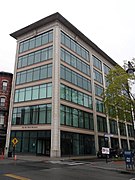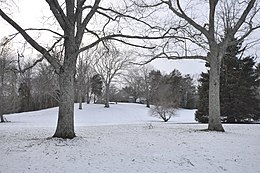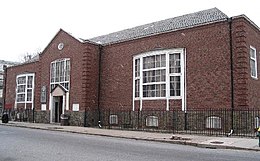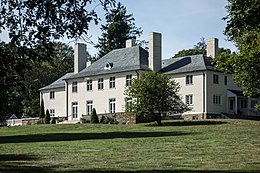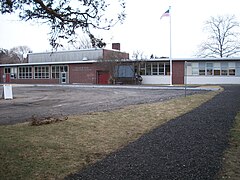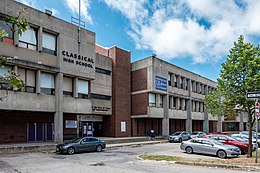User:JPRiley/sandbox/Harkness
| This is not a Wikipedia article: It is an individual user's work-in-progress page, and may be incomplete and/or unreliable. For guidance on developing this draft, see Wikipedia:So you made a userspace draft. Find sources: Google (books · news · scholar · free images · WP refs) · FENS · JSTOR · TWL |
Albert Harkness | |
|---|---|
| Born | November 8, 1886 |
| Died | January 5, 1981 |
| Nationality | United States |
| Occupation | Architect |
Albert Harkness
Life and career[edit]
Albert Harkness was born November 8, 1886 in Hamilton, New York to Albert Granger Harkness (1856–1923), a professor at Colgate University, and Katherine Margaret (Beebee) Harkness. He was named for his grandfather, classical scholar and educator Albert Harkness (1822–1907). The family returned to Providence in 1889 when Albert Granger joined his father on the Brown faculty.[1] Albert was educated in Switzerland but returned to the United States to attend Brown University, graduating in 1909. He then attended the Massachusetts Institute of Technology for graduate education in architecture, receiving his degree in 1912. He briefly joined the office of Jackson, Robertson & Adams in Providence[2] before going to New York, where he worked for Delano & Aldrich, H. Van Buren Magonigle and McKim, Mead & White. In 1913, while in the office of Delano & Aldrich, he was commissioned by his father to design an office building in Providence.[3] The resulting building, the Summerfield Building,[a] was the first office building in Rhode Island to utilize a reinforced concrete frame.[4]
Harkness returned to Providence in 1919 and established an independent practice following a commission in 1918 to design a Little Compton country house in 1918. He was sole owner of his firm until 1948, when he merged his office with that of Geddes & Kelly, the partnership of James Peter Geddes and Margaret Burnham Geddes (née Kelly). The new firm was known as the Office of Albert Harkness and Peter Geddes and also included Margaret Geddes, though she would leave in 1956 to take a job as a planner with the Providence Redevelopment Agency. Other principals in the firm included architect Donald S. Reed, who had worked for Harkness since 1922,[5] and engineer Randolph E. Anderson. Geddes retired from the firm in 1972, and Harkness retired in 1973, after which the office appears to have closed.[b]
Harkness joined the American Institute of Architects in 1921 and was elected a fellow in 1940. He served two terms as president of the Rhode Island Chapter, and for several years was a member of the national board of directors.
Personal life[edit]
Harkness was married in 1914 to Sara Arden Cheesman in New York City.
Harkness' son, John C. Harkness, was also an architect and would be a cofounder of The Architects Collaborative in 1945.
Legacy[edit]
Architectural works[edit]
Domestic work[edit]
Harkness intitially rose to prominence as an architect of suburban and country houses. His earliest known projects are several country houses in Little Compton and South Kingstown, Rhode Island, based on vernacular Colonial precedents.[7][8] His earliest sbuurban house was in North Attleborough, Massachusetts for Frederick B. Brigham (1922). When this house was listed on the National Register of Historic Places as part of the High, Church and Gould Streets Historic District in 1999, it was noted as one of the best examples of Colonial Revival architecture in the town.[9] It was about this time Harkness began basing his houses on French precedents, in a style then labelled "Provençal." He designed many of these in the 1920s and 1930s. Among others, these included Bramble Hill in Rehoboth, Massachusetts for Doris Mather Briggs (1923-28),[10] a house in Providence for Eugene Graves (1924)[11] and another in Wakefield for William Davis Miller (1934-35).[12]
Other residential projects included a house in Providence for Mary Kimball Hail (1928) in the Georgian style. Hail, a musician and patron of the arts, had a concert hall in the house. It is now known as "Music Mansion" and used for public performances.[13] For many larger works, Harkness preferred English Georgian or Regency models to their American varients. In addition to Music Mansion, later Georgian houses include a house in Jamestown for Neville Leary (1934)[14] and "Harbour Oaks" in Bristol for John S. Palmer (1938).[15] Regency houses include one in Providence for Elsie Coe Rice (1932)[11] and in Barrington for Arnold K. Brown (1940).[16]
Other smaller residential projects have been listed on the National Register of Historic Places. These include the remodeling of the Fisk Barn in Dublin, New Hampshire for Louis C. Gerry as an art studio (1929)[17] and remodeling of the Scholze–Sayles House in Pawtucket (1935).[18] The Fisk Barn, with its extensive use of glass, is noted as an early step towards Modernism in Harkness' work.[19] This was followed a few years later with a house in Little Compton for Edward Brayton (1937) in the Moderne style. Though in later practice Harkness would do little residential work, some Modernist houses of the 1940s and 1950s include additional country houses in Little Compton, including one for author Almet Jenks (1949), which incorporated salvaged farm buildings,[7] and another in Providence for Clarke Freeman Jr. (1954).[11]
Civic and commercial work[edit]
It was not until the 1930s that Harkness was commissioned for public and commercial projects. In 1929, the banker William Davis Miller, a long-time friend of Harkness, was elected president of the board of trustees of the Providence Public Library. Two years later Harkness designed the new Smith Hill Branch (1931-32), combining the Colonial and Moderne styles. He was also responsible for the Mount Pleasant Branch of the library (1948-49), in the International Style.[20] As the Great Depression worsened in the 1930s, Harkness designed a number of projects associated with New Deal-era programs. These included schools in Chepachet and Harmony in Glocester (1934-35),[21] a post office in Wakefield (1936)[8] and Eleanor Roosevelt Hall at the University of Rhode Island (1936-37).[22][21] All of these were based on Colonial precedents.
Full-fleged Modernism first appeared in Harkness' work in the later Great Depression, with the offices and factory for the California Artificial Flower Company in Providence (1939).[11] Designed in the Moderne style, it had much in common with projects like the building of the B B Chemical Company in Cambridge, Massachusetts, designed by Coolidge, Shepley, Bulfinch & Abbott in 1937. Despite efforts in the Moderne style, Harkness did not wholly embrace International Modernism until his association with Peter and Margaret Geddes. Their first collaborative project was the Mount Pleasant library (1948-49), and they continued with the new Elmwood branch of the Providence Institution for Savings (1949)[11] and the gymnasium at the Portsmouth Abbey School (1950). These were full-fledged Modern works. The latter project was designed in association with the Boston firm of Anderson & Beckwith.[23] These were followed by a series of public schools around the state, culminating with the East Greenwich High School (1965-67)[24] and the new Classical High School in Providence (1966-70).[11] Both of these moved away from the International Style, adopting Brutalist aesthetics. Additionally, both were designed in association with the The Architects Collaborative, where Harkness' son John C. Harkness was a partner.
In between their school projects, Harkness and his associates worked on other project types as well. The largest was the new Howard Building in Providence (1957-59), in a version of the International Style thought by local architectural historian William McKenzie Woodward thought to be "inappropritate" and "bland."[25] It has since been reclad. Other projects included two churches: The Friends Meeting House in Providence (1953)[11] and the Calvary United Methodist Church in Middletown (1962-63).[26] The former looks back to earlier Colonial precedents, while the latter is an A-frame structure inspired by old vernacular farmhouses.
Other late work included the Pell Marine Science Library (1967, demolished 2011) and the Horn Laboratory (1968) at the Narragansett Bay Campus of the University of Rhode Island.[27] These were both straightforward Modernist buildings. The firm gained its last major project in 1968, when in collaboration with Robinson, Green & Beretta and lead architects Perkins & Will won the commission to design the Knight Campus of the Community College of Rhode Island (1968-72). This was a Brutalist megastructure, inspired by the work of French Modernist architect Le Corbusier.[22] It was noted by Reyner Banham in Megastructure (1976) as one of the last such projects to be built in North America.[28]
Published works[edit]
- Schools, Glocester, Rhode Island[29]
- Gorham Company Showrooms, Providence, Rhode Island[30]
- Stairway[31]
- Gymnasium, Portsmouth Abbey School, Portsmouth, Rhode Island[32]
- Municipal Office Building, Providence, Rhode Island[33]
- Old Stone Bank, Providence, Rhode Island[34]
- Christopher Rhodes and Warren A. Sherman Elementary Schools, Warwick, Rhode Island[35]
- Classical High School, Providence, Rhode Island[36][37]
- East Greenwich High School, East Greenwich, Rhode Island[38]
- Knight Campus, Warwick, Rhode Island[39][40][41][42]
Gallery of architectural works[edit]
-
Summerfield Building, Providence, Rhode Island, 1913-14.
-
Bramble Hill, Rehoboth, Massachusetts, 1923-28.
-
Calart Tower, Providence, Rhode Island, 1939.
-
East Greenwich High School (former), East Greenwich, Rhode Island, 1956.
-
East Greenwich High School, East Greenwich, Rhode Island, 1965-67.
-
Classical High School, Providence, Rhode Island, 1966-70.
-
Knight Campus, Community College of Rhode Island, Warwick, Rhode Island, 1968-72.
List[edit]
Houses[edit]
House for William P. Buffum, 44 Round Pond Rd, Little Compton, Rhode Island (1918-19)[7]
- Vernacular.
House for Henry P. Cross, 40 White Pond Rd, South Kingstown, Rhode Island (1919)[8]
- Colonial.
"Marshside" for Franklin C. Southworth, 55 Swamp Rd, Little Compton, Rhode Island (1921, demolished)[7]
- Informal Colonial.
House for Frederick B. Brigham, 74 High St, North Attleborough, Massachusetts (1922)
- Informal Colonial Revival.
- Contributing property to High, Church and Gould Streets Historic District, NRHP 1999.
Bramble Hill for Doris Mather Briggs, Rehoboth, Massachusetts (1923-28)
- French Norman style.
- NRHP 1983.
House for Eugene Graves, 195 George St, Providence (1924)[11]
- French.
House for Abbott Phillips, 97 Round Pond Rd, Little Compton, Rhode Island (1926-27)[7]
- French.
"Stone House" for J. Bertram Lippincott, 216 Highland Dr, Jamestown, Rhode Island (1926)[43]
- French.
House for Mary Kimball Hail, 88 Meeting St, Providence (1928)
- Georgian
- A musician and patron of the arts, the house contains a small concert hall.
- Now known as "Music Mansion" and used for public performances.
House for John B. Lewis, 562 Post Rd, South Kingstown, Rhode Island (1928)[8]
- Colonial.
Remodeling of the Fisk Barn for Louis C. Gerry as an art studio, Dublin, New Hampshire (1929)[44]
- 1790s barn on Gerry's "Robinwood" farm, purchased by Gerry in 1924.[45]
- Early influence of Modern architecture, includes monumental two-story windows in place of barn doors.[46]
- NRHP 1983.
House for Elsie Coe Rice, 25 Cooke St, Providence (1932)
- Federal/Regency/Moderne.
House for Neville Leary, 314 Highland Dr, Jamestown, Rhode Island (1934)
- Colonial.
House for William Davis Miller in Wakefield, Rhode Island (1934-35)
- Georgian and French Norman architecture.
- NRHP 1985.
Remodeling of the Scholze–Sayles House in Pawtucket, Rhode Island (1935)[47]
- New Federal interior.
- NRHP 1983.
House for Sidney Clifford, 60 Freeman Pkwy, Providence (1936)[11]
- Federal.
House for William A. Phillips, 441 W Main Rd, Little Compton, Rhode Island (1936, demolished)[7]
- Informal Colonial
House for Edward Brayton, 552 W Main Rd, Little Compton, Rhode Island (1937)[7]
- Colonial/Moderne
"Harbour Oaks" for John S. Palmer, 125 Poppasquash Rd, Bristol, Rhode Island (1938)
- Georgian.
House for Arnold K. Brown, 9 Elm Ln, Barrington, Rhode Island (1940)
- Federal/Regency.
House for Almet Jenks, 64 Warrens Point Rd, Little Compton, Rhode Island (1949)
- Partially constructed from salvaged farm buildings.
House for William G. Nightingale, 49 Warrens Point Rd, Little Compton, Rhode Island (1950)[7]
- Informal Colonial
House for Clarke Freeman Jr., 70 Freeman Pkwy, Providence (1954-55)[11]
- Modernist.
House for William D. F. and Jacqueline Morrison, 130 Tower St, Bristol, Rhode Island (1960)[48]
- Ranch
Libraries[edit]
Smith Hill Branch of the Providence Community Library (1931-32)[49]
- Combines Colonial Revival and Moderne forms and details.
- NRHP 1985.
Mount Pleasant Branch of the Providence Community Library (1948-49)[50]
- First Modernist library in RI?
Schools[edit]
Chepachet and Harmony Schools in Glocester, Rhode Island (1934-35)[21]
- Georgian.
- Public Works Administration.
- Chepachet School now Glocester Town Hall.
Gymnasium, Portsmouth Abbey School, Portsmouth, Rhode Island (1950)[51]
- In association with Anderson & Beckwith.
- Later extended by Pietro Belluschi.
East Greenwich High School (former), 100 Cedar Ave, East Greenwich, Rhode Island (1955-56, demolished 2011)[52]
- International Style.
- Later Archie R. Cole Middle School.
Forest Avenue School, Middletown, Rhode Island (1957)[53]
East Greenwich High School, East Greenwich, Rhode Island (1965-67)
- In association with The Architects Collaborative.
- Brutalist.
Classical High School, Providence (1966-70)
- In association with The Architects Collaborative.
- Brutalist.
Colleges[edit]
Eleanor Roosevelt Hall at the University of Rhode Island (1936-37)[22]
- Built as dormitory for women, now classrooms and offices.
- Public Works Administration.
- Georgian.
- Contributing property to the University of Rhode Island Historic District, NRHP 2017.
Pell Marine Science Library, University of Rhode Island Narragansett Bay Campus, Narragansett, Rhode Island (1967, demolished 2011)[27]
Horn Laboratory, University of Rhode Island Narragansett Bay Campus, Narragansett, Rhode Island (1968)[27]
Knight Campus of the Community College of Rhode Island (1968-72)
- In association with Perkins & Will and Robinson, Green & Beretta.
- Megastructure.
- Inspired by the work of French Modernist architect Le Corbusier.
Post Offices[edit]
United States Post Office (former), Wakefield, Rhode Island (1936)[8]
- Colonial/Moderne.
Commercial buildings[edit]
Calart Tower, 400 Reservoir Ave, Providence (1939)[11]
- Headquarters of the California Artificial Flower Company.
- Moderne.
Providence Institution for Savings, Elmwood Branch, 520 Elmwood Ave, Providence (1949)[11]
- International Style.
Howard Building, Providence (1957-59)
- International Style.
- Later reclad.
Churches[edit]
Friends Meeting House, Providence (1953)
- Very simple Colonial.
Calvary United Methodist Church, Middletown, Rhode Island (1962-63)
- A-frame structure inspired by old vernacular farmhouses.
Notes[edit]
References[edit]
- ^ Harkness, Albert Granger
- ^ "Brunonians Far and Near," Brown Alumni Monthly 13, no. 2 (July 1912): 54.
- ^ "Providence, R. I." in American Contractor 34, no. 9 (March 1, 1913): 70.
- ^ William McKenzie Woodward, PPS/AIAri Guide to Providence Architecture (Providence: Providence Preservation Society, 2003)
- ^ "Reed, Donald Stenson" in American Architects Directory (New York: R. R. Bowker Company, 1970): 749.
- ^ 1976 Providence City Directory (Boston: R. L. Polk & Company, 1976)
- ^ a b c d e f g h Historic and Architectural Resources of Little Compton, Rhode Island (Providence: Rhode Island Historical Preservation Commission, 1990)
- ^ a b c d e Historic and Architectural Resources of South Kingstown, Rhode Island: A Preliminary Report (Providence: Rhode Island Historical Preservation Commission, 1989)
- ^ "NAL.E", mhc-macris.net, Massachusetts Historical Commission, n. d.
- ^ "REH.194", mhc-macris.net, Massachusetts Historical Commission, n. d.
- ^ a b c d e f g h i j k l William McKenzie Woodward and Edward F. Sanderson, Providence: A Citywide Survey of Historic Resources, ed. David Chase (Providence: Rhode Island Historical Preservation Commission, 1986)
- ^ William Davis Miller House NRHP Registration Form (1985)
- ^ College Hill Historic District NRHP Registration Form (1970)
- ^ ohtadmin, "Property on island sells for more than $5M," jamestownpress.com, Jamestown Press, August 1 2013. Accessed March 19 2021.
- ^ Historic and Architectural Resources of Bristol, Rhode Island (Providence: Rhode Island Historical Preservation Commission, 1990)
- ^ Historic and Architectural Resources of Barrington, Rhode Island (Providence: Rhode Island Historical Preservation Commission, 1993)
- ^ Fisk Barn NRHP Registration Form (1983)
- ^ Scholze–Sayles House NRHP Registration Form (1983)
- ^ William Morgan, Monadnock Summer: An Architectural Legacy of Dublin, New Hampshire (Boston: David R. Godine, 2011): 105.
- ^ John Hutchins Cady, The Civic and Architectural Development of Providence, 1636-1950 (Providence: Book Shop, 1957)
- ^ a b c University of Rhode Island Historic District NRHP Registration Form (2017)
- ^ a b c Rhode Island: State-owned Historic Properties (Providence: Rhode Island Historical Preservation Commission, 1989)
- ^ "Gymnasium Building for Priory School," Architectural Record 109, no. 5 (May 1951): 136-140.
- ^ Engineering News-Record 175, no. 16 (October 14 1965): 215.
- ^ Downtown Providence: Statewide Historical Preservation Report P-P-5 (Providence: Rhode Island Historical Preservation Commission, 1981)
- ^ James L. Yarnall, Newport Through its Architecture (Hanover and London: University Press of New England, 2005)
- ^ a b c "Harkness, Albert" in American Architects Directory (New York: R. R. Bowker Company, 1970): 376.
- ^ Reyner Banham, Megastructure: Urban Futures of the Recent Past (London: Thames & Hudson, 1976)
- ^ American Architect x, no. x (1937)
- ^ "Gorham Showrooms, Providence, R. I.," Pencil Points x, no. x (January 1941): 11-15.
- ^ "Selected Details," Pencil Points 23, no. 3 (March 1942): 161.
- ^ "Gymnasium Building for Priory School," Architectural Record 109, no. 5 (May 1951): 136-140.
- ^ "Public Use," Progressive Architecture (January 1951): 64.
- ^ "Bank Planning," Progressive Architecture (October 1952): 92-93.
- ^ "Deep classrooms are arranged in pinwheel wings to produce compact school for two different sites," Architectural Forum 100, no. 6 (June 1954): 130-131.
- ^ "New Kind of City School for Providence," Architectural Forum (December 1963): 11.
- ^ "Two-School Complex for Providence," Progressive Architecture 44, no. 12 (December 1963): 66.
- ^ "Courtyard High School Creates a Campus of a Beautiful Site," Architectural Record 144, no. 5 (November 1968): 164-166.
- ^ Architectural Forum x, no. x (December 1968): 95.
- ^ Interiors x, no. x (December 1969): 122-123.
- ^ Architectural Forum x, no. x (September 1973): 40-47.
- ^ Interiors x, no. x (November 1973): 98-105.
- ^ Historic and Architectural Resources of Jamestown, Rhode Island (Providence: Rhode Island Historical Preservation Commission, 1995)
- ^ Fisk Barn NRHP Registration Form (1983)
- ^ Robin Sweetser, "A Welcoming Yankee Homestead," nhhomemagazine.com, New Hampshire Home, July 2 2019. Accessed March 19 2021.
- ^ William Morgan, Monadnock Summer: An Architectural Legacy of Dublin, New Hampshire (Boston: David R. Godine, 2011): 105.
- ^ Scholze–Sayles House NRHP Registration Form (1983)
- ^ "Morrison, Jacqueline Virginia Briggs," Providence Journal, July 6 2007.
- ^ Smith Hill Branch—Providence Public Library NRHP Registration Form (1998)
- ^ John Hutchins Cady, The Civic and Architectural Development of Providence, 1636-1950 (Providence: Book Shop, 1957)
- ^ "Gymnasium Building for Priory School," Architectural Record 109, no. 5 (May 1951): 136-140.
- ^ Engineering News-Record 154, no. 9 (March 3 1955): 60.
- ^ "Proposals Opened for New School," Newport Daily News, January 25 1957, 8.


